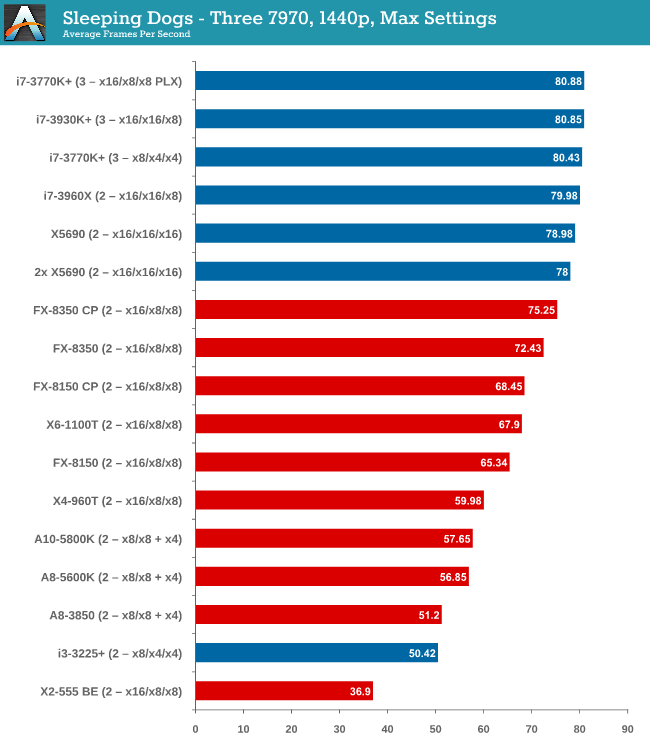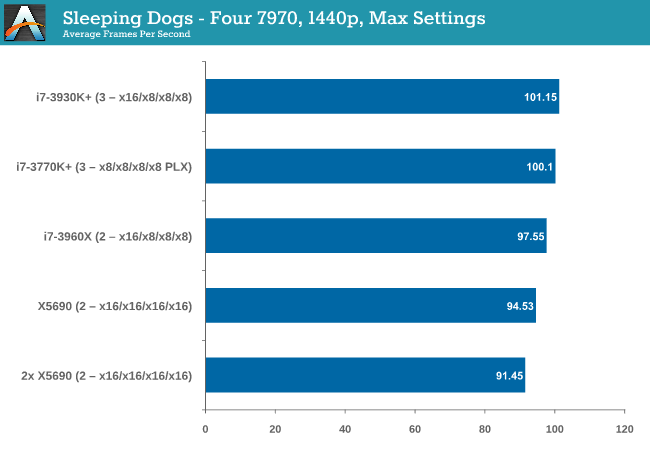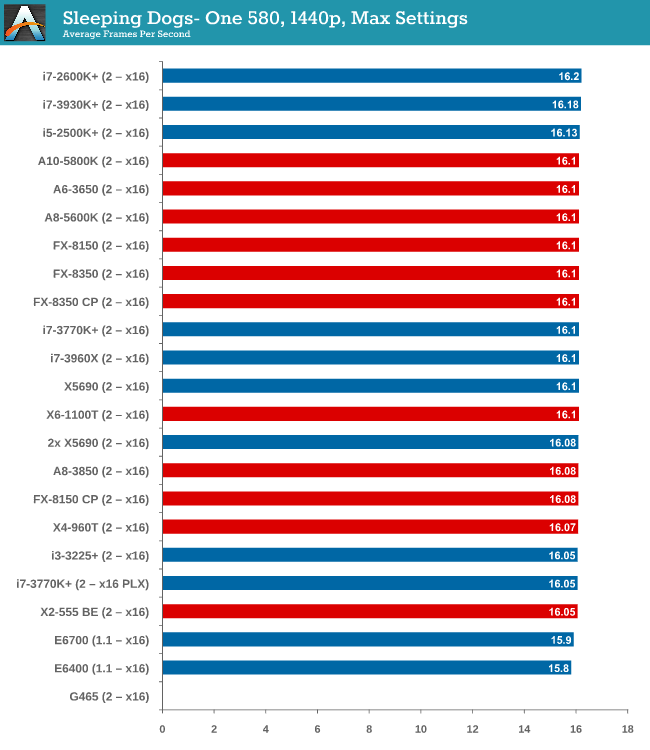Choosing a Gaming CPU: Single + Multi-GPU at 1440p, April 2013
by Ian Cutress on May 8, 2013 10:00 AM ESTSleeping Dogs
While not necessarily a game on everybody’s lips, Sleeping Dogs is a strenuous game with a pretty hardcore benchmark that scales well with additional GPU power. The team over at Adrenaline.com.br are supreme for making an easy to use benchmark GUI, allowing a numpty like me to charge ahead with a set of four 1440p runs with maximum graphical settings.
One 7970

Sleeping Dogs seems to tax the CPU so little that the only CPU that falls behind by the smallest of margins is an E6400 (and the G465 which would not run the benchmark). Intel visually takes all the top spots, but AMD is all in the mix with less than 0.5 FPS splitting an X2-555 BE and an i7-3770K.
Two 7970s

A split starts to develop between Intel and AMD again, although you would be hard pressed to choose between the CPUs as everything above an i3-3225 scores 50-56 FPS. The X2-555 BE unfortunately drops off, suggesting that Sleeping Dogs is a fan of the cores and this little CPU is a lacking.
Three 7970s

At three GPUs the gap is there, with the best Intel processors over 10% ahead of the best AMD. Neither PCIe lane allocation or memory seems to be playing a part, just a case of threads then single thread performance.
Four 7970s

Despite our Beast machine having double the threads, an i7-3960X in PCIe 3.0 mode takes top spot.
It is worth noting the scaling in Sleeping Dogs. The i7-3960X moved from 28.2 -> 56.23 -> 80.85 -> 101.15 FPS, achieving +71% increase of a single card moving from 3 to 4. This speaks of a well written game more than anything.
One 580

There is almost nothing to separate every CPU when using a single GTX 580.
Two 580s

Same thing with two GTX 580s – even an X2-555 BE is within 1 FPS (3%) of an i7-3960X.
Sleeping Dogs Conclusion
Due to the successful scaling and GPU limited nature of Sleeping Dogs, almost any CPU you throw at it will get the same result. When you move into three GPUs or more territory, it seems that having the single thread CPU speed of an Intel processor gets a few more FPS at the end of the day.










242 Comments
View All Comments
colonelclaw - Thursday, May 9, 2013 - link
Jarred, I would fully agree with banning any person who continually makes no contribution to the discussion. These comment sections often supply me with useful information, and can be read as a continuation of the article itself. Having to hunt for the valuable opinions amongst piles of cretins and idiots makes me want to go elsewhere.extide - Thursday, May 9, 2013 - link
Please ban him, and I would consider myself a pretty solidly Intel guy myself, but you have to be realistic. Sheesh!Blibbax - Thursday, May 9, 2013 - link
Ban him and anyone else remotely similar.duploxxx - Friday, May 10, 2013 - link
if all would start voting to ban this person there would be a huge amount or thread reply :)Jon Tseng - Wednesday, May 8, 2013 - link
Hmmm. So bottom line is my 2007-vintage QX6850 is perfectly good a 1080p so long as I get the a decent GPU.Bizarro state of affairs when a 6 year old CPU is perfectly happy running cutting edge games. Not sure if I should blame the rise of the GPU or the PS3/XBox360 for holding back gaming engines for so long!
TheInternal - Wednesday, May 8, 2013 - link
In games that are CPU limited (like Skyrim or Arkham Asylum), no. I continue to get the impression from both personal experience and articles/reviews like this that once you have "enough" CPU power, the biggest limiting factor is the GPU. "Enough" often seems to be a dual core operating at 3.0GHz, but newer titles and CPU bound titles continue to raise the bar.Azusis - Wednesday, May 8, 2013 - link
Agreed. Especially in multiplayer situations. Try running PlanetSide 2 or Natural Selection 2 with a core2quad like I do. It isn't pretty. But just about any other singleplayer game... sure, no problem.TheInternal - Wednesday, May 8, 2013 - link
So... these were all tested on a single monitor? Though the article has lots of interesting information, I'd argue that doing these tests on a three monitor 1440p setup would show much more useful information that consumers looking at these setups would be able to apply to their purchasing decisions. It's great to see more reviews on different CPU + multiple GPU configurations, as well as the limitations of such settings, but by limiting such tests to an increasingly unlikely usage scenario of a single monitor, the data becomes somewhat esoteric.Kristian Vättö - Wednesday, May 8, 2013 - link
Did you mean three 1080p monitors (i.e. 5760x1080) by any chance? 7680x1440 is a very, very rare setup especially for a gamer. For work purposes (e.g. graphics designer, video editor etc) it can be justified as the extra screen estate can increase productivity, but I've never seen a gamer with such setup (heck, the monitors alone will cost you close to $2000!). I'm not saying there aren't any but it's an extreme minority and I'm not sure if it's worth it to spend hours, even days, testing something that's completely irrelevant to most of our readers.Furthermore, while I agree that 5760x1080 tests would be useful, keep in mind that Ian already spend months doing this article. The testing time would pretty much double if you added a second monitor configuration as you'd have to run all tests on both configs. Maybe this is something Ian can add later? There is always the trouble of timing as if you start including every possible thing, your article will be waaay outdated when it's ready to be published.
TheInternal - Thursday, May 9, 2013 - link
I didn't mean three 1080p monitors, which does seem to be the "common" three monitor configuration I've seen most gamers going for (since it's cheap to do with 24" panels being under $200 a pop) My 27" S-IPS 2560x1440 panel cost about $300, so I'm not sure where you're getting the $2000 figure from... and if you spend $1500-$2000 on the graphics subsystem, why wouldn't you be spending at least half as much on the monitors?Most modern high-end graphics cards should be able to easily handle three 1080p monitors in a three card config... possibly a two card config... a round up like this would be much more useful to consumers if it did include such information... as well as show just how well the different CPU and GPU combos worked with multiple monitors.